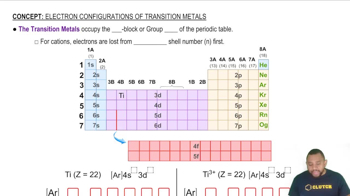Determine whether HI can dissolve each metal sample. If it can, write a balanced chemical reaction showing how the metal dissolves in HI and determine the minimum volume of 3.5 M HI required to completely dissolve the sample. a. 2.15 g Al

Determine if HNO3 can dissolve each metal sample. If it can, write a balanced chemical reaction showing how the metal dissolves in HNO3 and determine the minimum volume of 6.0 M HNO3 required to completely dissolve the sample. a. 5.90 g Au b. 2.55 g Cu c. 4.83 g Sn
 Verified step by step guidance
Verified step by step guidance
Verified video answer for a similar problem:
Key Concepts
Acid-Base Reactions

Stoichiometry

Metal Reactivity

Determine whether HI can dissolve each metal sample. If it can, write a balanced chemical reaction showing how the metal dissolves in HI and determine the minimum volume of 3.5 M HI required to completely dissolve the sample. b. 4.85 g Cu
Determine whether HI can dissolve each metal sample. If it can, write a balanced chemical reaction showing how the metal dissolves in HI and determine the minimum volume of 3.5 M HI required to completely dissolve the sample. c. 2.42 g Ag
The cell potential of this electrochemical cell depends on the pH of the solution in the anode half-cell. Pt(s) | H2(g, 1 atm) | H+(aq, ? M) || Cu2+(aq, 1.0 M) | Cu(s) What is the pH of the solution if Ecell is 355 mV?
The cell potential of this electrochemical cell depends on the gold concentration in the cathode half-cell. Pt(s) | H2(g, 1.0 atm) | H+(aq, 1.0 M) || Au3+(aq, ? M) | Au(s) What is the concentration of Au3+ in the solution if Ecell is 1.22 V?
A friend wants you to invest in a new battery she has designed that produces 24 V in a single voltaic cell. Why should you be wary of investing in such a battery?
